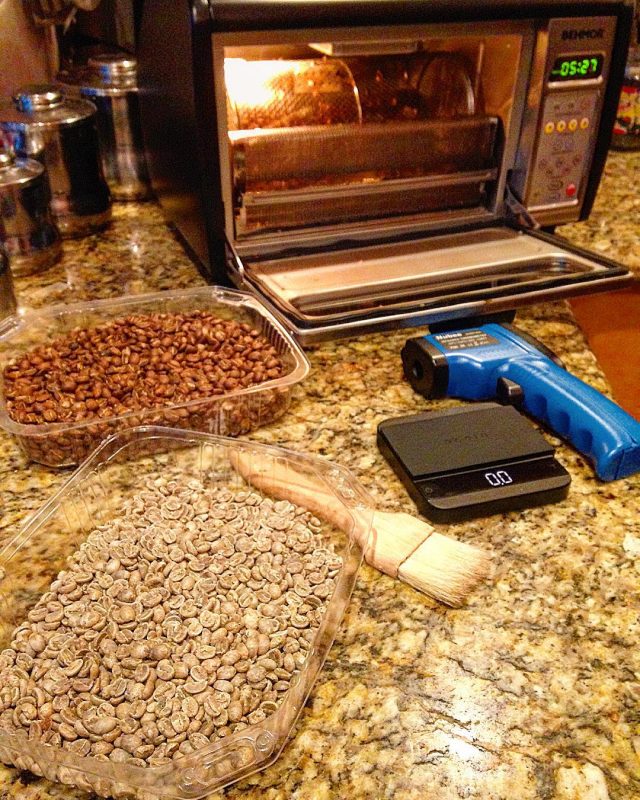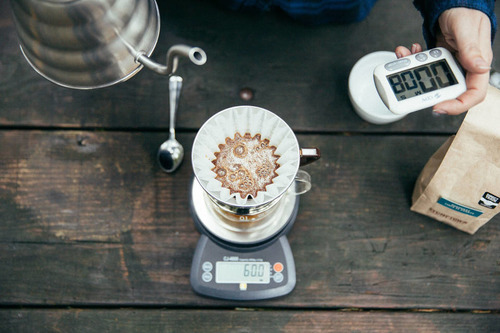Introduction to coffee roasting: suggestions on storage methods of raw beans and bean roasters

For professional baristas, please follow the coffee workshop (Wechat official account cafe_style)
The issues related to the storage of raw beans and the baking machine were originally planned in the essay, but at my slow pace, I'm afraid you'll already be impatient by the time the manuscript comes out, so give a brief answer in advance. it may solve some of your current problems.
Let's start with the way raw beans are stored. You will ask this question to prove that you are a coffee player who bakes your own beans, and is well aware of the cruel fact that raw beans can be preserved for quite a long time (unlike cooked beans, which usually lose flavor more than ten days after baking). However, as time goes by, the good flavor hidden in the raw beans will be lost bit by bit. Over the years, how to prolong or maintain the good quality of raw beans has always been an important issue for coffee lovers and people in the industry. Many foreign experts and coffee groups have studied this issue and published a large number of research results.
The conclusion is quite simple: the ideal storage should be to keep raw beans in an environment that avoids exposure to moisture and odors, slows respiration and prevents oxygen from entering the beans. In other words, it is the best known way to pack it in a vacuum bag and then put it in the freezer.
However, the problem is that vacuum freezing requires space and electricity. Maintaining this state for a long time is not a small expense, and not everyone can afford it or is willing to afford it. For example, the coffee industry in Taiwan has only a few freezers for storing raw beans, and even they are only willing to vacuum freeze expensive high-end beans, while raw beans at ordinary prices are still stored in the traditional way. I have generally adopted this model for many years, and I will give a further explanation.
For the needs of my family and the club, I usually keep 20 or 30 kinds of fine beans from different producing areas or estates at any time, but because I don't run the coffee business, the quantity of each kind of beans is not much, roughly between half a kilogram and five kilograms. To put it simply, it means "small and diverse." In order to facilitate the storage and use of so many kinds of beans, they are divided into three grades (self-made grades) according to the price of beans, that is, "universal beans" with prices ranging from 300 to 400 yuan to 800 or 900 yuan per kilogram; "intermediate beans" from 1,000 to 2,000 yuan per kilogram; and "high-grade beans" with a price of more than 2,000 yuan per kilogram. Only a small number of high-end beans that need to be stored for a long time (for example, a year or so) will be stored in vacuum, while other beans are just sealed and placed in cabinets that are cool and not exposed to moisture, odor and sunshine. consume them as much as possible within six months (because there are new beans in the warehouse at any time). By the way, my refrigerator, due to the intervention of vacuum frozen beans, has almost become a battlefield between my wife and me, and the result is not difficult to predict: the ownership of the refrigerator, the woman is always the winner. Fortunately, coffee is also a daily necessity for my wife, and finally, she agreed to cut out a small space in the restaurant and let me put a mini-refrigerator, which can barely solve the problem of placement of coffee beans.
If you have vacuum frozen raw coffee beans, remember one thing: get the beans back to room temperature before sending them to the toaster. It's easy to move the beans out of the freezer the day before.
Let's move on to your second question. In fact, what you ask should be divided into two items:
(1) what kind of bean baking machine do I use
(2) can I give you some advice on baked beans?
As for (1), I can give you a simple answer. The one I currently use, SAN FRANCISCAN 1 lb Roaster- Profile Roaster, is a small professional bean dryer, semi-hot air style, the ideal weight of the beans is 200kg 600g, the weight of one kilogram is also acceptable. Because it can be baked continuously, nearly two kilograms of ripe beans can be baked in an hour on average. If the coffee shop is used for business, it may be too small for beans, but it is more than enough for our May 4th Coffee Club. This machine won the first place in the US boutique coffee roasting competition one year, but I can't remember which year it was.
As for (2), I find it a little difficult to answer. Because the word "advice" is quite general, you are not sure what you really want to know; at the same time, baked beans are the hardest thing to explain, either theoretically or technically. I can only do this: regard you as a new member of the May 4th Coffee Club and take the first lesson to guide new members in baking beans as a "suggestion" to provide you with a reference.
Because the "first lesson" is designed to let beginners enjoy the fun of baking beans, all the principles and changes involved, such as "Why do you do this?" , "what other different practices are there?" Wait, it is difficult to explain in depth, I hope you can understand this. When I write about baked beans in the future, I will try to add the missing part.
According to experience, people who bake coffee beans for the first time mostly start with simple equipment, such as direct fire drum (manual or motor driven), hand net, frying pan, etc. Of course, some of them are afraid of trouble, simply buy a household, such as Hot Top, I-Roast, Fresh Roast this kind of fully automatic or semi-automatic small bean baking machine. Few people buy a professional bean dryer in the first place (unless you plan to open a coffee shop), and I think you are no exception.
Here are my suggestions.
First of all, we need to figure out three things:
(1) which category should the equipment you use fall into? Direct fire, hot air or semi-hot air?
(2) how well are the beans scheduled to be roasted? Light, medium, deep roast, etc. (or more professional names, Cinimann roast, City roast, Full City roast, etc. )?
(3) what kind of baking curve do you want to plan? That is, the time it takes to reach the four critical moments, and the mode of heat supply (strong fire, medium fire, small fire, etc.). The four critical moments mentioned here refer to the recovery point (in the closed baked bean space, when the bean temperature is consistent with the furnace temperature), the start of the Mena reaction (Maillard reaction), the start of the first explosion, and the start of the second explosion (if you are not going to roast deeply, you can drop the beans before the second explosion).
With regard to (3), some additional explanations are needed. Among the four critical moments, "first explosion" and "second explosion" can be judged by hearing, because the sound of the first explosion is loud and scattered, and the sound of the second explosion is small and dense, as long as the noise produced by baked beans does not cover up the explosion sound, it can be clearly distinguished by actual operation several times. The "Mena reaction" can be judged by vision and smell: visually, the bean color begins to turn yellow; in the sense of smell, you can begin to smell something similar to toast. Only the "temperature recovery point", in the lack of temperature probe on the simple equipment, it is probably impossible to detect, for the time being can not care about.
Second, among the different baking curves, I usually recommend the following model, which is not easy to fail, and the whole process is divided into six stages:
In the first stage, from the lower bean to the temperature recovery point, the firepower is the least.
In the second stage, from the temperature recovery point to the Mena reaction, the firepower was slightly increased, but the small fire was still maintained.
In the third stage, from the Mena reaction to the explosion-intensive time, it is adjusted to the fire (not so big as to scorch the beans)
In the fourth stage, when the explosion is dense, the firepower will be reduced immediately to roughly the same as the first stage.
In the fifth stage, when there is an explosive silence, immediately increase the firepower to the same level as the second stage, and then maintain the firepower until the moment of the second explosion (either before or after the second explosion)
In the sixth stage, add the beans, then cool the beans to room temperature as soon as possible.
If you are not particular about it, roasting coffee is as simple as that. Even, as long as you follow the heating method mentioned above, that is, using a wok, like fried peanuts, you can get good results. In fact, most of the members of our May 4th Coffee Club went through the stage of "stir-fried coffee beans" before buying various types of bean roasters. Finally, I would like to remind you that the simple baked bean equipment is easily affected by the external environment, which is different from the professional bean dryer. For example, the baking curve used for baking beans at 30 degrees at room temperature must be adjusted to make up for the temperature difference when used at 20 degrees at room temperature. As for how to adjust it, it is up to your own experience to judge.
Important Notice :
前街咖啡 FrontStreet Coffee has moved to new addredd:
FrontStreet Coffee Address: 315,Donghua East Road,GuangZhou
Tel:020 38364473
- Prev

Introduction to coffee roasting: SCAA coffee roasting color card explanation
For professional baristas, please follow the coffee workshop (Wechat official account cafe_style) SCAA coffee roasting color card SCAA number: 25 roasting name: Itatian Roast Italian roasting bean time: before the oil seeps out slightly, SCAA number: 35 roasting time: French Roast French roasting bean time: second burst peak SCAA number: 45
- Next

Is hand-made coffee really good? Why does coffee smell better than it tastes?
Communication of professional baristas Please pay attention to the coffee workshop (Wechat official account cafe_style) the smell of coffee is more enjoyable than drinking coffee, this is true, because most of the coffee aromas are volatile and can be felt by the sense of smell; some are volatile and water soluble, which can be felt by the sense of smell and taste; a few are water soluble and can only be felt by the sense of taste. A little sweet and sour wind
Related
- Beginners will see the "Coffee pull flower" guide!
- What is the difference between ice blog purified milk and ordinary milk coffee?
- Why is the Philippines the largest producer of crops in Liberia?
- For coffee extraction, should the fine powder be retained?
- How does extracted espresso fill pressed powder? How much strength does it take to press the powder?
- How to make jasmine cold extract coffee? Is the jasmine + latte good?
- Will this little toy really make the coffee taste better? How does Lily Drip affect coffee extraction?
- Will the action of slapping the filter cup also affect coffee extraction?
- What's the difference between powder-to-water ratio and powder-to-liquid ratio?
- What is the Ethiopian local species? What does it have to do with Heirloom native species?

